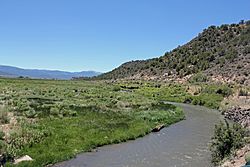Culebra Creek facts for kids
Quick facts for kids Culebra Creek |
|
|---|---|

The creek near the town of San Luis
|
|
| Country | United States |
| Location | Costilla County, Colorado |
| Physical characteristics | |
| Main source | Junction of El Valle Creek and Carneros Creek 37°10′58″N 105°14′13″W / 37.1827°N 105.2369°W |
| River mouth | Rio Grande 37°10′44″N 105°43′47″W / 37.1790°N 105.7297°W |
| Length | 30 mi (48 km) |
Culebra Creek (also called Culebra River or Río Culebra) is an important stream in Costilla County, Colorado. It begins where two smaller creeks, El Valle Creek and Carneros Creek, join together. From there, it flows into the famous Rio Grande, about 11 miles east of Manassa, Colorado. Culebra Creek is about 30 miles (48 km) long.
Contents
History of Culebra Creek
Early Settlements Along the Creek
Culebra Creek holds a special place in Colorado's history. In 1851, the very first European settlers to live permanently in Colorado made their homes along its banks. These early pioneers chose this spot because the creek provided essential water for their farms and daily lives.
The San Luis People's Ditch
Culebra Creek is the source of something very important called the San Luis People's Ditch. This ditch is an acequia. An acequia is a community-built water channel that carries water from a river or stream to farms and homes. It's like a small, shared canal.
The San Luis People's Ditch was given the highest priority water rights in Colorado. This means that its users have the first claim to the water from Culebra Creek, even before anyone else. This was a big deal for the early settlers and continues to be important today.
Acequias in the Culebra Creek Area
The entire area around Culebra Creek, known as its watershed, supports fourteen different acequias. These traditional water systems are still used by local communities. They help share the water fairly among many people for farming and other needs. These acequias show how important Culebra Creek has been for generations of people living in the area.

